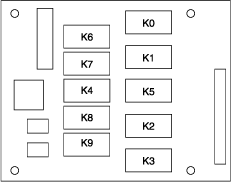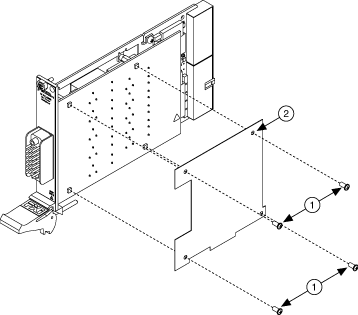NI PXI-2586 Relay Replacement
The NI PXI-2586 uses electromechanical armature relays.
Refer to the following table for information about ordering replacement relays.
| Relay Manufacturer | Part Number |
|---|---|
| Potter & Brumfield (Tyco Electronics) | RTB14005F (2-1419108-4) |
Complete the following sets of steps to disassemble your module and replace a failed relay.
Disassemble the Module
- Ground yourself using a grounding strap or a ground connected to your PXI chassis.

Note Properly grounding yourself prevents damage to your module from electrostatic discharge. - Locate the relay you want to replace. Refer to the following figure and table for relay locations.

Channel
NameRelay
NameCH0 K0 CH1 K1 CH2 K2 CH3 K3 CH4 K4 CH5 K5 CH6 K6 CH7 K7 CH8 K8 CH9 K9 - Remove the four screws from the back of the relay board, and carefully peel off the plastic safety shield.

1 Screws 2 Plastic safety shield
Replace the Relay
Make sure you have the following:
- Temperature-regulated soldering iron set to 300 °C
- 60/40 Lead/Tin solder (flux core)
- Solder wick
- Fine pick
- Isopropyl alcohol
- Cotton swabs
If you have a surface mount rework station, replace the relay as you would any other surface mount part. Otherwise, complete the following steps to replace the relay:
- Use the soldering iron and solder wick to remove as much solder from the relay pads as possible. Do not leave the soldering iron on any lead for more than 5 seconds.

Note If it is necessary to reapply the soldering iron to the pad, allow the connection to cool completely before reapplying the soldering iron. - Apply heat to the pads one at a time, and use the pick to gently pry the relay pins from the pads. Make sure that the solder is molten before prying.

Caution Using excessive force on a soldered pad can result in lifting the PCB trace and ruining the daughterboard. - Remove the relay.
- Clean the pads with isopropyl alcohol and cotton swabs.
- Place the new relay on the PCB pads and solder.
- Remove the excess flux with isopropyl alcohol and cotton swabs.

Caution Do not use flux remover to clean the board after relay replacement.
Reassemble the Module
Secure the plastic safety shield using the four screws removed in Disassemble the Module, step 3.
 |
Tip In NI-SWITCH 3.1 or later, you can use the Switch Soft Front panel to reset the relay count after you have replaced a failed relay. |